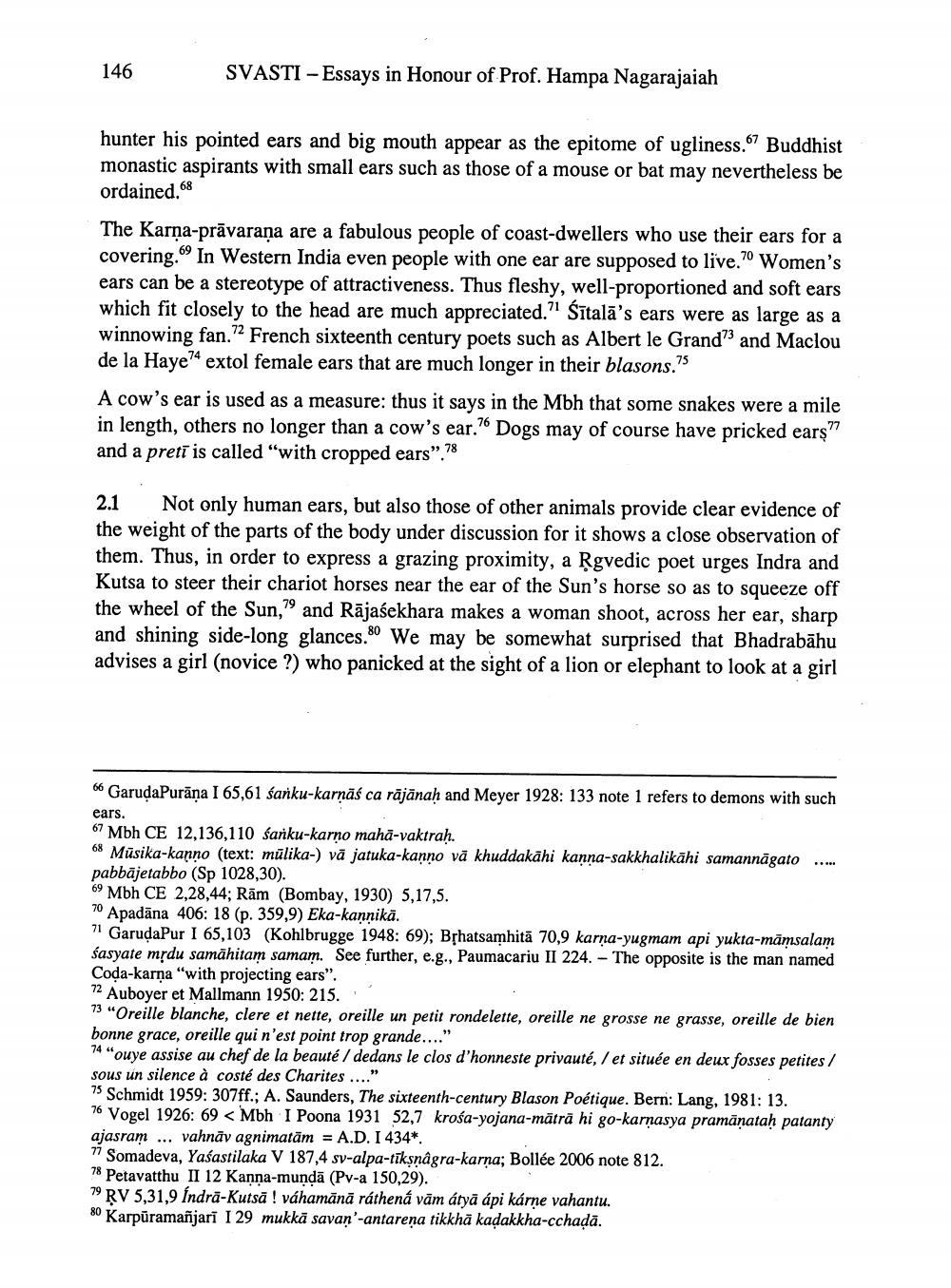________________
146
SVASTI – Essays in Honour of Prof. Hampa Nagarajaiah
hunter his pointed ears and big mouth appear as the epitome of ugliness. Buddhist monastic aspirants with small ears such as those of a mouse or bat may nevertheless be ordained.68
The Karna-prāvarana are a fabulous people of coast-dwellers who use their ears for a covering.69 In Western India even people with one ear are supposed to live.70 Women's ears can be a stereotype of attractiveness. Thus fleshy, well-proportioned and soft ears which fit closely to the head are much appreciated." Šītalā's ears were as large as a winnowing fan." French sixteenth century poets such as Albert le Grand" and Maclou de la Haye74 extol female ears that are much longer in their blasons.75
A cow's ear is used as a measure: thus it says in the Mbh that some snakes were a mile in length, others no longer than a cow's ear. Dogs may of course have pricked ears and a pretī is called "with cropped ears”.78
2.1 Not only human ears, but also those of other animals provide clear evidence of the weight of the parts of the body under discussion for it shows a close observation of them. Thus, in order to express a grazing proximity, a Řgvedic poet urges Indra and Kutsa to steer their chariot horses near the ear of the Sun's horse so as to squeeze off the wheel of the Sun," and Rājasekhara makes a woman shoot, across her ear, sharp and shining side-long glances. We may be somewhat surprised that Bhadrabāhu advises a girl (novice ?) who panicked at the sight of a lion or elephant to look at a girl
66 GarudaPurāna I 65,61 śanku-karņāś ca rājānah and Meyer 1928: 133 note 1 refers to demons with such ears. 67 Mbh CE 12,136,110 śarku-karno mahā-vaktrah. 68 Musika-kanno (text: mülika-) vä jatuka-kanno và khuddakahi kanna-sakkhalikāhi samannāgato pabbājetabbo (Sp 1028,30). 69 Mbh CE 2,28,44; Rām (Bombay, 1930) 5,17,5. 70 Apadāna 406: 18 (p. 359,9) Eka-kannikā. 71 GarudaPur I 65,103 (Kohlbrugge 1948: 69); BỊhatsamhitā 70,9 karņa-yugmam api yukta-māmsalam śasyate mȚdu samāhitam samam. See further, e.g., Paumacariu II 224. - The opposite is the man named Coda-karna "with projecting ears". 72 Auboyer et Mallmann 1950: 215. 13 "Oreille blanche, clere et nette, oreille un petit rondelette, oreille ne grosse ne grasse, oreille de bien bonne grace, oreille qui n'est point trop grande... 74 "ouye assise au chef de la beauté / dedans le clos d'honneste privauté, / et située en deux fosses petites / sous un silence à costé des Charites ...." 75 Schmidt 1959: 307ff.; A. Saunders, The sixteenth-century Blason Poétique. Bern: Lang, 1981: 13. 76 Vogel 1926: 69 < Mbh I Poona 1931 52,7 krośa-yojana-mātrā hi go-karṇasya pramāṇatah patanty ajasram ... vahnāv agnimatām = A.D. I 434*, 77 Somadeva, Yaśastilaka V 187,4 sv-alpa-tīksnågra-karna; Bollée 2006 note 812. 78 Petavatthu II 12 Kanna-mundā (Pv-a 150,29). 79 RV 5,31,9 Indrā-Kutsā ! váhamānā ráthená vām átyā ápi kárne vahantu. 80 Karpūramañjari I 29 mukkā savan'-antarena tikkhā kadakkha-cchadā.




